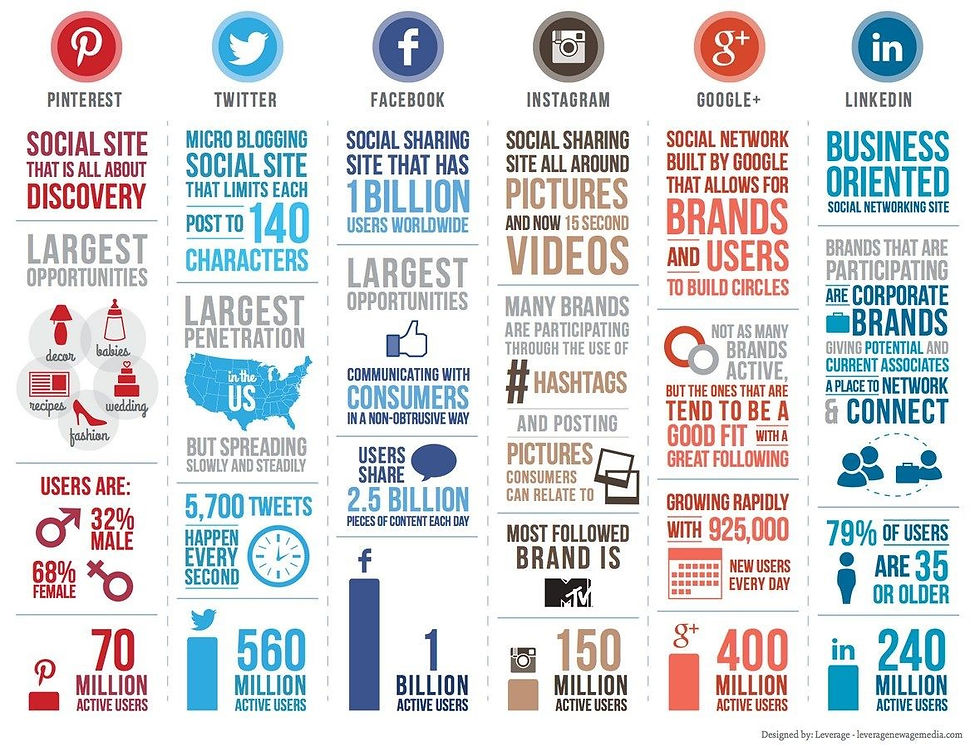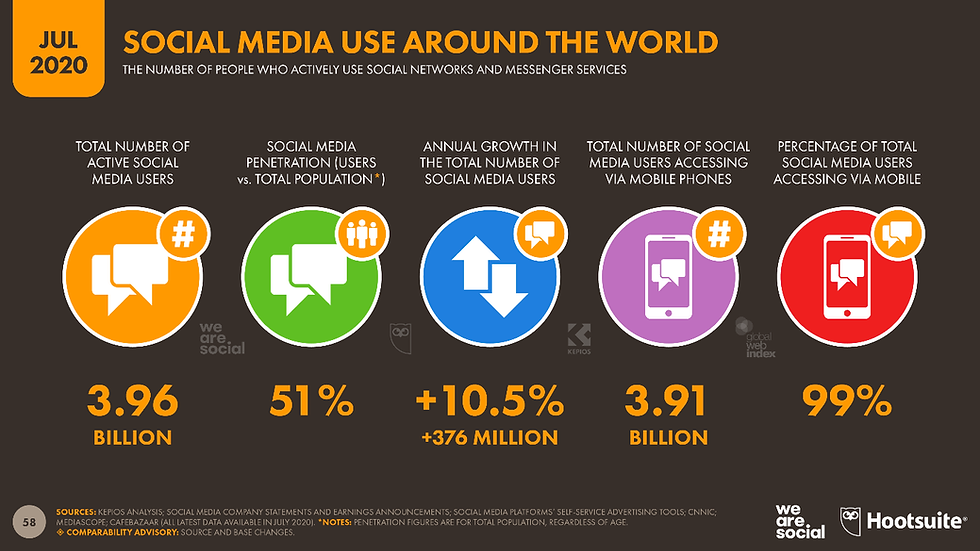Social Media Marketing FAQs
Struggling with social media marketing?
Discover the answers you’re looking for regarding social media marketing
Social Media Marketing Questions…
· Does my business need to be on social media?
Simply yes!
Explanation: There are approximately 2.77 Billion people worldwide with at least one social media account (Statista, 2019) and where there are people, there is potential leads.
Marketing, in its purest form, is literally showing your product to the most likely group of people to purchase.
Whatever your business, brand or offering, whether it’s B2C or B2B, however unexciting your product might be, no matter how small your business is, regardless of how tiny your niche market may be, you will be able to find your target market on social media.
If customers aren’t coming to you, or don’t know about you, you need to go to them.
Social media is the perfect place to do that, whether you’re building awareness of your brand or products, generating leads or targeting sales.

· What is the best social network for my business?
That depends.
Explanation: This is one of the most commonly asked questions that I receive and although it’s pretty straightforward to answer when I know more about a business, it’s impossible to answer for all businesses.
Whilst I can’t tell you the second network (because it’s completely industry and target market dependent), I do suggest that all businesses and brands use Facebook and at least one other.
Of the 2.77 Billion worldwide social media users, 2.3 Billion log on to Facebook at least once a month. This huge percentage is just too big to ignore.
The world’s biggest social network is an amazing place to build social proof, act as a directory (many people use Facebook to research a business), build a following and promote your business (more on this later).
Facebook is a tool that is right for just about any business in 2020. Though paid ads can become cumbersome and expensive, they’re totally optional. Your best bet is to have an active account to keep in touch and connect with users. If you have the budget and but no time, The Marketing Manager can assist.
YouTube is a great social media platform for business in 2020 and beyond. It will likely take a little time upfront to learn how to shoot and edit videos that meet users’ expectations, but you don’t need a Hollywood budget. Most up-to-date smartphones are more than capable of recording high-quality videos.
Depending on your commitment to social media marketing, Twitter can be a powerful tool for building brand awareness and connecting directly with other customers (not to mention other influencers). Keep in mind that Twitter needs its own marketing strategy, and you’ll need to plan for multiple tweets per day.
LinkedIn is kind of like owning a pair of nice dress shoes: you’ll likely use them less often, but you should really have them in your closet. While you can (and should) show off your brand with a LinkedIn business page, it’s core function is tailored to individual use and expanding your professional network.
Pinterest can be a great traffic driver to your site, but it’s better suited for some businesses than others. Home decor, cooking recipes, photography sites, and travel are all examples of businesses that can thrive on Pinterest. Why? Because they have content that is typically visually appealing and easily shared.
Instagram is great if your audience is younger and typically shopping from mobile. Plus, Instagram created a “Checkout” feature which means it’s fully set up for eCommerce. Now, your clients can look at product images and purchase what they like directly from their Instagram account.

· What is the best way to grow my following on social media?
Give people a reason to follow you!
Explanation: A massive social media marketing mistake (that I see all the time) is businesses that do nothing but promote themselves and their products.
The best way to grow a following is create a profile that a specific target audience (your market) want to follow. This means posting content that appeals to them, offering competitions to win items by sharing your content, becoming the go to page for questions and product information.
Your social content should educate, inform and entertain your target audience in a way that appeals to them.
Think about your content medium (e.g. written, video, audio, imagery) and content style.
Follow these 9 steps and your sure to grow your social media following:
1. Choose the right social platform
First things first, understand that just because there is a social platform, doesn’t mean you need to be on it.
You need to understand what the platform really does, who uses it, how people use it, and determine whether it makes sense for your business to have a presence.
With that being said, your brand should be on the platform(s) your consumers are on. Having great content on Facebook and a highly active presence means nothing if your buyer persona isn’t there as well.
2. Analyse your competitors
Something you should be consistently doing in marketing is analysing your competitors — and that stands true for social media as well.
What platforms are they active on? What kind of content are they sharing? How often are they sharing?
Understanding your competitor's social media strategies and engagement will help you establish a roadmap of what you should be doing as well.
Even more importantly, by analysing your competitors, you will discover opportunities to differentiate yourself as a brand in the eyes of the target consumers you are competing for.
3. Complete your profiles (yes, your personal ones too)
Now that you’ve determined where to build your profiles, it’s time to do the dirty work.
Be accurate and up-to-date
Almost every social media platform has a summary area, profile picture, and cover photo where you can enter and showcase information about your business — make sure that this is accurate and up-to-date across all of your platforms.
4. Be consistent with your brand
When I say consistent, I mean the overall tone of your social media presence needs to match your established personality, values, and voice.
Your written bio should match your profile image which should match your cover photo which should match your content.
Even more so, if you are using multiple social media platforms, be sure that each account tells the same story and projects the same tone for your company.
5. Share awesome content
While this may be one of the more “no-brainer” ways to build a following, having content your followers want to see and engage with is crucial and cannot be overlooked.
Sharing quality content for your audience members will help establish your company — and personal brand — as a thought leader within your own industry.
The challenge in sharing awesome content is knowing what awesome content actually is!
People want to see more than just text and need something visually appealing to catch their eye. Users on Facebook, Instagram, and Twitter all showed massive engagement activity with visual content for both image and video:
6. Connect with industry thought leaders and influencers
After hearing the 70:20:10 rule, you are probably wondering “Where can I come up with 20% of the content on my page if the content isn’t actually mine?”
As I briefly mentioned earlier, connecting with industry influencers is going to be a great tactic in developing your social media strategy and building a significant social media following.
These companies or individuals are the thought leaders in your industry that your customers and target audience are following. Tap into that resource!
7. Use hashtags
You have this awesome content and are engaging with your audience, but how do you better optimize your posts to get found by new people?
Use relevant hashtags #
Similar to a keyword on a website or blog article, hashtags are used to help your social posts perform better in search results. Users are able to follow these hashtags directly or can search them to find related posts.
8. Utilise paid advertising and sponsored posts
Now that you’re up and running on your social media platform, it’s time to take things one step further.
Organic views will only get you so far and they are becoming increasingly difficult to achieve, because the platforms are smart and want you to pay to play in order to achieve that social media elite status.
However, social media advertising is one of the most cost-effective ways to engage with a new, targeted audience.
Facebook advertising
As you have learned, users seeing your awesome content is crucial to building a following on social media. However, with Facebook’s recent algorithm changes, content being posted by friends and family are now prioritized over brand pages.
If users aren’t seeing my content, how will I ever build a Facebook following?
This is where Facebook advertising comes into play.
Facebook advertising can be hugely beneficial for your organization because of the vast number of people using the platform and robust targeting tools you have at your disposal.
Whether you are looking to promote users to like your page or want to push specific content you are sharing, you have a good chance of reaching the users you want to reach because of Facebook’s ability to target very specific factors beyond gender and location, including life events, purchase behaviours, and interests.
9. Engage with your audience
It can be easy to get caught up in the followers and likes on social media platforms. However, once you build your audience, you absolutely need to engage with them to maintain it.
React to posts you are mentioned in, answer questions when asked, and reply to comments made about your content.
If you simply want to get more eyes on your posts, boosting them will get you there.
But if you want to build your following and drive engagement with the right audience, you will need to do much more specific and targeted advertising so the right content is getting to the right people.

· Should I advertise on social media?
As you will have already read yes!
Explanation: If you’re serious about digital marketing and growing your presence online, social media ads are well worth the investment.
As a marketer, business owner or entrepreneur, financially backing your business and products shouldn’t intimidate you, it should excite you.
Social media ads offer you the opportunity to be seen by more of your target market in a place where they hang out. They can be primed to build awareness, grow followings, engage an audience, generate leads and make sales…
…and when you know how to use them effectively, it can have massive positive implications for your business.
The social networks you should use for advertising will depend on your industry and the demographics of your target market, but Facebook is the best places to start.
Facebook ads allow you to precisely target an audience by tons of different behaviours and demographics, including location, interests, likes, browsing history, age…the list goes on and on…
· How often should I post on social media?
Short answer, 3 or 4 times a week if not every day. Long answer, it varies from network to network.
Explanation: You should post fresh content on your social profiles every week.
Posting regularly will engage your audience, build your awareness and following, keep your brand visibility high and make your brand feel fresh and up-to-date.
When people see your brand they are reminded of it when they need to make a purchase in your industry and are much more likely to become a customer.
· What kind of posts should I publish?
The kind your target market will love and drive engagement!
Explanation: The answer to this question goes back to the earlier question about how to grow your social following.
A great social media marketer understands everything about their target market and uses this to create a posting strategy, including the type of posts they publish.
Great posts educate, inform or entertain audiences, and as a general rule, you should always aim to tick at least one of those boxes.
If you’re unsure, analyse your competitors and try to find their best performing posts. Your target market will be similar, so their posting strategy is probably worth replicating.
I’d also recommend testing with a variety of content mediums, this means writing long form content, posting links, images, videos and short post updates.
· What is the best time to post on social media?
Shortly before your target audience are most likely to be online and as consistently as possible.
Explanation:
You have to be consistent. That means never letting your posting schedule run empty. It means posting at the perfect time every single day, giving you the best chance of reaching your target audience at a time preferred by them, not you!
The network you use and the market you’re targeting will hand you the best times to post. Try to find the answers to the following questions:
· What time do your target market work?
· What are their jobs?
· Do they commute?
· When are they most likely to have some downtime to visit social media?
· What kind of posts are most relevant to them at different times of the day?
· Are your social media posts time relevant (e.g. are you calling your audience to read a long content post at a time when they can only visit social briefly?)?
· What do they use social for? How does this affect the time they login?
· What are the social media analytics telling you?

· How can I measure success on social media?
This depends on your digital goals, but the most common answers are engagement level, follower count and conversions driven from social.
Explanation: The straight answer is, it all depends on your goals. Are you using social to build brand awareness? To grow your digital presence? Generate leads? Convert leads into customers?
For many of you, it will be all of those things, but the difficulty is splitting them into separate metrics.
These are the metrics I’d suggest using for each of those aims:
· Brand Awareness: Like, share and comment rate (and count) and follower growth
· Digital Presence: Follower, share count, website traffic driven from social
· Lead generation: Number of leads generated from social, tracked by Insights or by Conversions>Goals on Google Analytics
· Conversions: Revenue generated from social, including average order value, customer count and conversion rate. Tracked by Conversions>Goals on Google Analytics.
· Identify Key Performance Indicators: Your Key Performance Indicator or “KPI” can potentially help you identify what is working or what is not working. Identifying your KPIs could help you determine what you hope to accomplish by utilizing social media.
· What tools will help improve my social media performance?

Explanation: There are a million different social media tools that can improve your performance (and for the next 3 months, I’m probably going to receive emails from all of them, asking to be added to the short list I’m about to put together).
We use lots of different tools to improve our performance, here are a few of my favourites described very briefly (because I could probably create an entire post about this subject).
· Buzzsumo: This tool displays the most shared content on social for any given keyword. This is useful when you’re coming up with ideas around a subject that you know your target market enjoy. Use Buzzsumo’s most shared social content as a guideline for your content ideas.
· Canva: We have in-house designers, but whenever we’re short on designs or somebody needs something knocked up quickly, Canva is the place we go first. It’s full of templates, tons of different designs and elements and is incredibly versatile. If you’re in a small team without designers, Canva should already be on your radar.
· Analytics: Almost every social network has their own ‘Analytics’ section built in for business pages. Facebook, Instagram and Twitter all have their own analytics (or ‘Insights’) section to help businesses. Use the data here to help you optimise your social performance.
· All-Hashtag: There are loads of hashtag generation tools, but this is our most trusted. All-hashtag allows users to find the ‘Top’, ‘Live’ or ‘Random’ hashtags around their chosen keyword. Use this tool to help increase your reach on social.
· Google Analytics: The uses of Google Analytics are endless and that includes helping you improve your social media performance. The key to optimisation is analysis, and GA’s incredible array of data tracking tools will highlight the strengths or weaknesses in your social media performance.
Conclusion
Those are the most commonly asked social media marketing questions as asked by you.
Hopefully the answers in this social media marketing FAQ’s page have been of some help or directed you to a page where you can get a more detailed insight.
If you’re still stuck, feel free to reach out to either myself or a member of our team. We’re always happy to help!
Comments